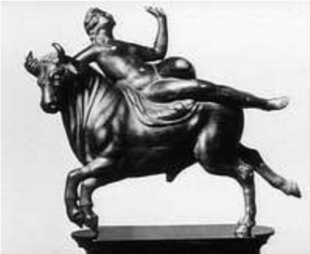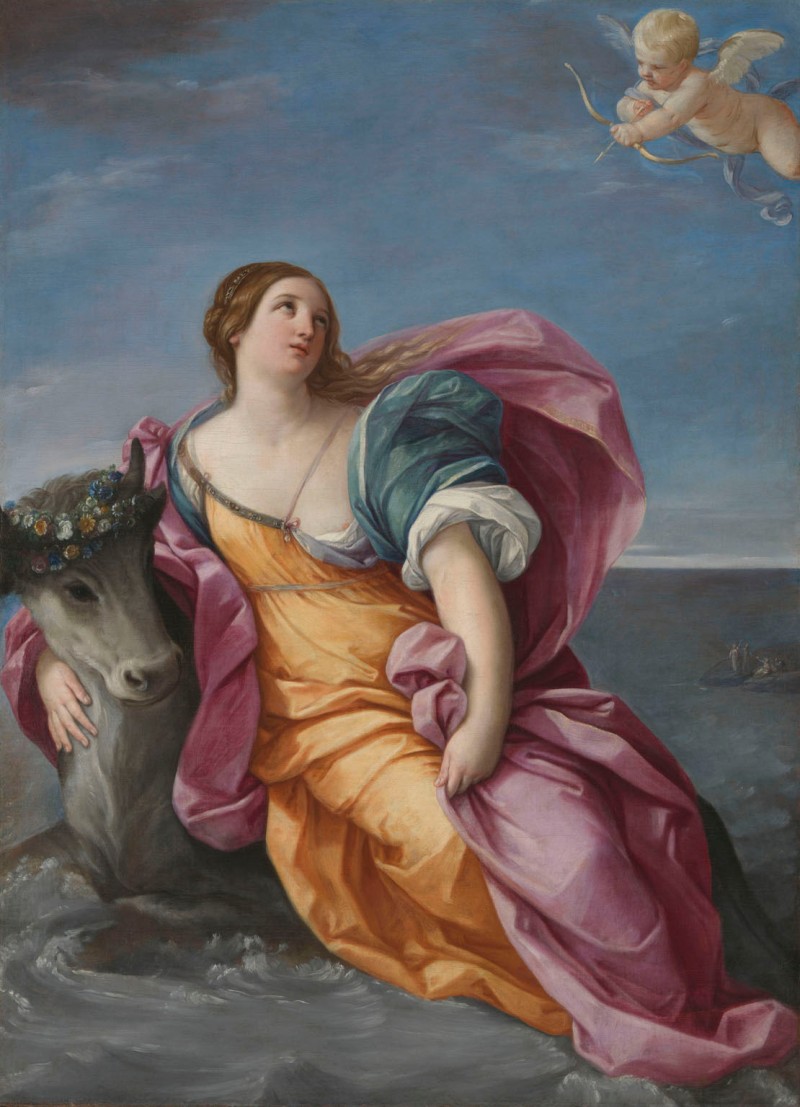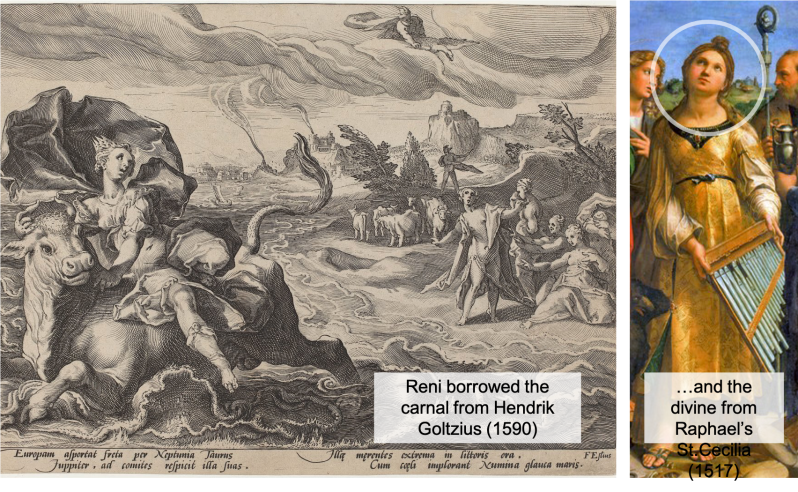Previously on The Rape of Europa…
Part I – In Antiquity, the age of discovery and adventure, the myth of Europa was a prologue to more exciting stories. Europa was not a victim, just a participant in the grand scheme of things.
Part II – Late Middle Ages and the Renaissance: Search for emotions in the plot and a new meaning of the story. Durer vs Titian. Artists discovered that high-level emotions can be combined with violence and eroticism. First signs of women’s empowerment in art with Europa’s making the bull do her bidding.
Quiz: Why Rubens copied Titian’s Rape differently to the original and what conjugal infidelity, Jesuits and Velazquez had to do with it
Today, we’ll go through the Baroque.
But before we knock on the door of the Baroque, let’s take a step back and talk about a pivotal change in medieval mentality that made nudity possible at all. I should have done it before, I know (when a book deal arrives, I’ll put this chapter in its proper place, ha-ha).
In the last few years of the 12th century, the future Pope Innocent III (the actively crusading one) wrote a book titled On the Misery of Human Condition. It described man (meaning, of course, men and women) as a repulsive vessel of sin with zero potential:
“…For sure man was formed out of earth, conceived in guilt, born to punishment. What he does is depraved and illicit, is shameful and improper, vain and unprofitable. He will become fuel for the eternal fires, food for worms, a mass of rottenness.”
The future Pope wouldn’t stop there. His description of humans is getting more and more revolting:
‘Man was formed of dust, slime, and ashes; what is even viler, of the filthiest seed. He was conceived from the itch of the flesh, in the heat of passion and the stench of lust, and worse yet, with the stain of sin. He was born to toil, dread, and trouble; and more wretched still, was born only to die.”
One might think that so much hate towards the human body would be a direct path to celibacy, sleepless nights of exalted prayer intermitted by feverish masturbation, and the ultimate extinction of the adepts of this body-negativism. Alas, most princes of the church were both lying hypocrites and lying with mistresses, fathering enough of illegitimate children to keep their bloodlines and ideas in circulation. It took two centuries for this rejection of the human body to change. The revival of the classical past was sowing doubt that, perhaps, the man had a potential of achieving something of value before his death, was worthy of happiness in this world, and that, maybe, a human body ought to be enjoyed, and its beauty could be celebrated, just the way the ancients had been doing it in their own art.
The Renaissance not only brought back interest in and respect of the human body but successfully married luxury and eroticism.

In the 15th century, it was porn for the rich. Donatello’s David was put in Medici’s garden where only select few could see it, Durer’s sketch of Europa never made it beyond the blueprint stage, and Boticelli had to graft his Venus with Rapunzel hair to keep her modest.
But as soon as the 16th century arrived, the nudes exploded. From Giorgione’s Sleeping Venus and Kranach’s apple-breasted Eve to the pornographic pottery with Europa, naked mythical women started adorning the walls, ceilings, and cupboards of aristocratic houses.
The same artists were doing spiritually uplifting religious pieces and profane porn, like Agostino Carracci or Giulio Romano. The same clients would pay top florin to buy both.
As the 17th century rolled in, with Europe torn between warring Catholicism and Protestantism, Baroque art with all its nudity became a powerful tool for the Catholic elites to show their superiority over their Protestant counterparts. Catholics were presenting themselves an emotionally brave and intellectually advanced bunch of people that, most importantly, had much more fun in their life than the grim Protestants whose entertainment diet consisted of still-lifes, boring guild portraits, and music evenings, when friends would gather to play music to demonstrate how badly they mastered their instruments. Yes, badly, no mistake there: those who played music well could raise suspicion of being akin to musicians in their character, and the latter were distrusted by the Protestant society for their allegedly lewd lifestyle. Thus, to maintain a reputation, one had to purposefully make a show of accidentally missing the right notes.
This is why the Church did not strongly object to the onslaught of nudity – the only morals that Ancient Goddesses could lower by flashing their breasts were those of the elites exposed to this kind of art (and their morals were at rock bottom anyway), so, ultimately, nudity was helping the Catholic cause.
Catholic Baroque
With this kind of introduction, you’d probably expect a drove of nude Europas riding their bulls, but no, we would only have a few interesting ones. The closer we get to the present, the more difficult it becomes for artists to surprise us with something new, right?
Let’s start with a Mannerist statuette by the Baroque prophet Giambologna. This Flemish sculptor decided to become Italian and was so successful in this undertaking that the Medici rulers of Florence wouldn’t allow him to leave the city until his death (truth be told, in compensation, they provided him with a luxury lifestyle and splendid tomb).

Giambologna’s Europa is reclining on the Bull in a way that makes one wonder if he had seen Titian’s eponymous painting before casting his bronze.
Both Europas raise their left hand, both look up to the sky, both are lounging with their back on the Bull, and the only difference is that this one is entirely naked although in a more decent pose.
If Giambologna wanted to show violent resistance, he wouldn’t hesitate to do it. In a similar story (of a centaur crazy enough to attempt abduction of Hercules’s wife) he sculpted a no-nonsense fight for life (clickable – when I was taking these photos in Berlin, the lust, the fear, the tear of muscles – it was all palpable):
So, Europa’s lack of fight is intentional. Her hand (different to Titian) does not cover her face – it is turned to Heaven in the last hope for salvation. Giambologna marries an ancient myth to the Christian mindset and iconography – forty years before Guido Reni painted his Europa for the King of Poland and was credited with marrying salvation of the soul to the old myth.

What is extraordinary about this Europa, is that Reni shows her trying to maintain her dignity by holding onto her cloak and at the same time caters to the profane demands of his client by pulling down her gown and revealing her nipple. That nipple adds more eroticism to her than if he’d painted her breasts naked. In fact, such an attempt was made by one of Reni’s apprentices. Guido Cagnacci undressed Europa in 1650 and posed her suggestively, losing – in my view – both divinity and eroticism in the process:

Yet, I must give credit where credit’s due. Cagnacci’s use of colour is remarkable – more than 50 years before the first colour wheel appeared he was using perfectly toned complementary colours: red flowers against the green tunic, and orange hair against the blue sky! Europa’s conjuctivitis is a problem though – but who knows, perhaps, it was an allusion to a strong breeze at sea that day?


Guido the Apprentice could be blamed for borrowing from his teacher’s work, were Guido the Master innocent of the same transgression. Reni was also appropriating a lot from his predecessors, albeit in a more creative way and – most importantly – he was inventing something new on top.
The well-circulated print after Hendrik Goltzius’ engraving (1590) provided him with a compositional idea that reflected carnal passion. He replaced the Eagle (another Zeus incarnation) with a half-angel/half-cupid, removed desperation and fear, and turned Europa into a saint, using St.Cecilia altarpiece by Raphael (1516-1517) to incorporate the Christian tradition of depicting saints. As a hardcore Bolognese, Reni was well aware of this altarpiece in San Giovanni church not far from his home.

It is a fun fact that today Guido Reni is well known internationally; not by name though, but by one of his works that has become a viral meme. As you can see, Guido Reni was not shy about nudity in general – his choice for Europa’s slip of attire was carefully premeditated.

I would skip now quite a lot of Baroque painters: their competition at exposing Europa’s breasts was rather dull, and they failed to move the plot, artistically.
The next innovation (almost thirty years after Reni) came from Claude Lorrain, who would become an inspiration for all the landscape artists of the next century. In his own age, he revolutionised mythological painting by reducing the importance of what people did in the myth to the absolute minimum and replacing human emotion with the feeling he created via inventing and arranging nature, which became the protagonist in his paintings.

This job was commissioned by Cardinal Chigi, who, while Claude Lorrain was working on the painting, got elected Pope Alexander VII. He would become known, if not by name – for it is hard to keep track of all the Popes – then by his deeds. Much of what we love about Rome today was conceived and built during his 12-year reign.
It was not the first time (and not the last) Lorrain painted the myth, but here he finally allows the landscape to dominate it completely.

The core concept here is that while an ancient myth might have its storytelling beauty followed by a moral lesson, that beauty can be better shown via a harmonious arrangement of landscape and architectural elements as substitutes for human emotion. Neoplatonism for artists was about the impossibility of creating or showing the ideal – art could be just an approximation of it. The ideal oak may only exist in the brain of a god: you’ll never find it no matter how many oak groves you visit. All the real trees would be deviations with deficiencies.
Europa might be one of the ideal beauties, and her story a perfect representation of forced love and subsequent salvation, but Lorrain felt that it was much easier (and more convincing for the viewer) to get an approximation of these relationship concepts via using trees, coastlines, and mountains as proxies.
Here’s a shortcut to understanding the three paths taken by the Catholic Baroque to present the myth of Europa (and, actually, pretty much everything else)

To get a Lorrain was a sign of enlightenment, to commission Europa as a saint was commonplace, and to have her naked was like broadcasting a machismo manifest, although the opposite was also true: the official lover of Louis XIV once ordered a portrait of herself as Europa to inform the French King, “I am all yours”.

It could be an interesting exercise to ask contemporary rulers to choose one Baroque painting they like. Imagine Trump going for Lorrain and breaking all the stereotypes to dust!
I find it amusing that an intellectual feat equal in its heroics to reading “salvation” between the lines containing “abduction” and “rape” is re-enacted today. Come to think of it, the ideas of unification, tolerance, multiculturalism, all those values that are referred to as European – constitute a philosophy bordering on religion, with its own inquisition, its own power structures, its own fanatics and heretics*. How come Europa on/later beneath the Bull is still one of the most important symbols of the EU and is even seen as its founding myth? Yes, there is a contemporary statue of Europa and the Bull in front of the Council of Europe building in Brussels.
I thought that the Greek version of the 2 euro coin (yes, there’s Europa on the Bull on the reverse) was a tongue-in-cheek nod towards the rich nations like France and Germany, a coded message “You took us in, you screwed us, now pay us damages” or something like that.
As it turns out, it was serious. The explanation I’ve encountered recently was that “The myth of Europa and the Bull […] is a significant and sexy image of Europe reinventing itself as the European Union.”
I love an allegory just as the next man, but how do you read rape as reinvention? Is it about trusting all women except Europa because Zeus told reporters in his crystal-clear Shakespearean English that it was her who “hang upon my tongue like a new-married wife about her husband’s neck, hardly to be shook off”?
Where’s a #MeToo activist when you need one?
In the meantime, I am off to finish the Lutheran Baroque, Rococo, fast-forward through the Neo-Classicism, and end with Modernist and contemporary take on Europa, hopefully, all in one go.
* I am all for these values, it’s the poorly educated fanatics that scare me – fanatics of any movement, religious, political or art-historical.





The only problem with your blog/articles is that I am so quick to ‘play hooky’ from my work and current deadlines in favour of reading you analysis and discourse on paintings –and discovering new works I did not know and minor artists you highlight and that we, trained in Art History, too often dismiss in favour of the more established or significant ones. Now I have to go back to work but there is still one of your articles waiting for me tomorrow! Treat.
PS: all compliments are sincere….
PPS: Remember though, when you discuss artists being influenced or ‘copying’ other artists two things for your readers:
a) it was common practice in those times for younger artists to make copies of older Masters (obvious nonetheless valid note: they did not have illustrations or photographs then).
b) as TS Eliot wrote: “Mediocre poets ‘borrow’, genius poets ‘steal’ “…. 🙀😂
Thank you! ) Making a professional art historian play hooky to read my take on art is the highest praise!
As for copying… at those times, printed engravings have become quite common – and that facilitated the exchange of ideas that the world hadn’t seen before – I will talk about it in the next chapter about the Lutheran Baroque. As for stealing – I am all for it! Reni was stealing and then he created something at least mildly new, and his apprentice, in my view at least, was borrowing – and stayed a relatively minor artist even though he could become a famous colourist. If only he knew how to steal!
PS While I was working on the quiz about Rubens, I thought about mentioning what a genius marketer he was – when he set up the process of engraving his paintings and then distributing prints all over Europe – the first artist to realise that “like-repost-like” is the key to popularity and success – centuries before Instagram or Twitter )
Simply brilliant!
Thank you )
Love this
Glad you enjoyed it! ) As I said in my mission statement, art history can be a lot of fun )
Interesting take on the subject.
Leslie
Thank you!)